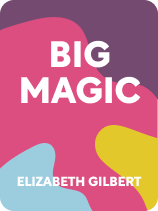

This article is an excerpt from the Shortform book guide to "Big Magic" by Elizabeth Gilbert. Shortform has the world's best summaries and analyses of books you should be reading.
Like this article? Sign up for a free trial here .
Is Elizabeth Gilbert’s Big Magic worth reading? What is the key premise you can take away from the book?
Big Magic is author Elizabeth Gilbert’s guide to leading a more fulfilled life by making creativity, in any guise that suits you, a part of your daily existence. The book offers both spiritual wisdom on how to work with the magical forces of creativity, as well as suggestions on how to create effectively and productively.
The following Big Magic book review covers the book’s context, background, and critical reception.
About the Author
Elizabeth Gilbert is a bestselling author. Her first published work was a short story collection, Pilgrims (1997), which was a finalist for the PEN/Hemingway award. She followed this with a novel, Stern Men (2000); and a work of nonfiction, The Last American Man (2002), which was a finalist for the National Book Award and the National Book Critics Circle Award. During her early career, she also worked as a journalist for Spin, GQ, and The New York Times magazine.
Gilbert became a household name when her best-selling memoir, Eat Pray Love, was published in 2006. In it, Gilbert recounts her post-divorce journey to Italy, India, and Indonesia to make sense of her life. Eat Pray Love sold over 10 million copies globally and was adapted into a film starring Julia Roberts in 2010. One critic later would describe the mania over Eat Pray Love as “Gilbert fever.” In 2008, TIME listed Gilbert as one of its 100 most influential people.
Some critics of Gilbert’s felt that Eat Pray Love marked a decline in her career. They saw her smash-hit memoir as being self-involved and insubstantial and a step down from her more serious journalistic work.
After Eat Pray Love, Gilbert published Committed in 2010, which chronicles her love affair-turned-marriage with a Brazilian man she met in Indonesia (about whom she first wrote in Eat Pray Love). In 2013, she published The Signature of All Things, a novel about a 19th-century female botanist’s around-the-world adventures. She followed this up with Big Magic in 2015, and, in 2019, City of Girls, a novel that follows a young woman arriving on the New York theater scene in the 1940s.
Connect with Elizabeth Gilbert:
The Book’s Publication
Publisher: Penguin Books USA
Big Magic was published in 2015 by Penguin, an imprint of Penguin Random House. It was Gilbert’s fifth book overall but her first book that falls within the self-improvement and self-help category.
Historical and Intellectual Context
Gilbert based Big Magic on two TED Talks she gave in 2009 and 2014. In her first, entitled “Your elusive creative genius,” she presents some of her ideas around genius and the irrationality of the creative process. The second, “Success, failure and the drive to keep creating,” revolves around sticking with a creative pursuit through both success and failure.
On the broad spectrum of books on creativity, Big Magic falls closer to the end dealing with creativity’s links to spirituality and faith than to the end dealing with creative productivity and success. It thus has more in common with Julia Cameron’s The Artist’s Way, which approaches creativity as a way to self-actualize, than with Ed Catmull’s Creativity Inc., which provides actionable advice on how to build a creative team.
The Book’s Impact
Big Magic was a New York Times bestseller. While not as influential as Eat Pray Love, it helped position Gilbert as not just an author but also a self-help guru (particularly for women). In 2015, she appeared on The Late Show with Stephen Colbert to discuss Big Magic. She now appears on podcasts, in YouTube series, and even at spirituality and psychology conferences to discuss creativity and spirituality.
Gilbert continues to expand her creative identity and influence. In 2020, she founded the Onward Book Club on Instagram, in which she speaks with Black female writers about their books.
Critical Reception
Big Magic reviews were mixed. Some readers felt its ideas were sound, inspiring, and worthy of implementation. Others felt the book was insubstantial, lacking in concrete actionables, and too fluffy to motivate creativity over the long run. Negative critics also thought the book as a whole was Gilbert-centric: that it provided recommendations that worked for Gilbert but might not work for everyone.
Furthermore, some readers struggled with Gilbert’s belief in magic that underpins much of the book. Her perspective on creativity is rooted in mysticism rather than science, and most of her views are unprovable and must be taken at face value. Finally, some objected to the “cutesy” expressions of how creativity worked: for instance, the presentation of an idea as an entity that has agency and can leave you if you don’t pay enough attention to it.
Commentary on the Book’s Approach and Organization
Gilbert tackles the concept of creativity from six different angles in Big Magic, each of which has its own chapter: courage, enchantment, permission, persistence, trust, and divinity. However, the discussions in each chapter are only loosely linked to the title: For instance, the chapter on courage mainly discusses fear and coping with it.
The book reads more like a collection of Gilbert’s musings and stories on a particular aspect of creativity than as a set of guidelines. In the chapter about enchantment, for instance, Gilbert relays an anecdote about how an idea first visited her before transferring to the mind of author Ann Patchett as almost the exact same idea. This anecdote illustrates how Gilbert envisions ideas working (that they can move from person to person), but there are no concrete actions or recommendations to be drawn from it.
This loose structure and indirect approach reflect Gilbert’s own views on and approach to creativity. She conveys in her book that creativity involves a high degree of “magic”: in other words, irrational, unexplainable, possibly supernatural input. To present such ideas on creativity in a highly structured and methodical way with many actionables would not only be difficult, but it would also somewhat defeat the purpose of the book itself.
Overall, Gilbert’s aim seems to be to inspire and catalyze readers using her own experiences and learning, not to provide concrete tips or suggestions.

———End of Preview———
Like what you just read? Read the rest of the world's best book summary and analysis of Elizabeth Gilbert's "Big Magic" at Shortform .
Here's what you'll find in our full Big Magic summary :
- Why integrating creativity into your daily life will make you feel more fulfilled
- Why creating for money is a form of self-sabotage
- Why you should never focus on external validation of your creations






